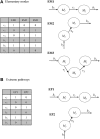Plant metabolic modeling: achieving new insight into metabolism and metabolic engineering
- PMID: 25344492
- PMCID: PMC4247579
- DOI: 10.1105/tpc.114.130328
Plant metabolic modeling: achieving new insight into metabolism and metabolic engineering
Abstract
Models are used to represent aspects of the real world for specific purposes, and mathematical models have opened up new approaches in studying the behavior and complexity of biological systems. However, modeling is often time-consuming and requires significant computational resources for data development, data analysis, and simulation. Computational modeling has been successfully applied as an aid for metabolic engineering in microorganisms. But such model-based approaches have only recently been extended to plant metabolic engineering, mainly due to greater pathway complexity in plants and their highly compartmentalized cellular structure. Recent progress in plant systems biology and bioinformatics has begun to disentangle this complexity and facilitate the creation of efficient plant metabolic models. This review highlights several aspects of plant metabolic modeling in the context of understanding, predicting and modifying complex plant metabolism. We discuss opportunities for engineering photosynthetic carbon metabolism, sucrose synthesis, and the tricarboxylic acid cycle in leaves and oil synthesis in seeds and the application of metabolic modeling to the study of plant acclimation to the environment. The aim of the review is to offer a current perspective for plant biologists without requiring specialized knowledge of bioinformatics or systems biology.
© 2014 American Society of Plant Biologists. All rights reserved.
Figures


Similar articles
-
Green genes: bioinformatics and systems-biology innovations drive algal biotechnology.Trends Biotechnol. 2014 Dec;32(12):617-26. doi: 10.1016/j.tibtech.2014.10.003. Epub 2014 Oct 21. Trends Biotechnol. 2014. PMID: 25457388 Review.
-
Computational Approaches to Design and Test Plant Synthetic Metabolic Pathways.Plant Physiol. 2019 Mar;179(3):894-906. doi: 10.1104/pp.18.01273. Epub 2019 Jan 15. Plant Physiol. 2019. PMID: 30647083 Free PMC article. Review.
-
Engineering plant metabolism into microbes: from systems biology to synthetic biology.Curr Opin Biotechnol. 2013 Apr;24(2):291-9. doi: 10.1016/j.copbio.2012.08.010. Epub 2012 Sep 15. Curr Opin Biotechnol. 2013. PMID: 22985679 Review.
-
Plant genome-scale metabolic reconstruction and modelling.Curr Opin Biotechnol. 2013 Apr;24(2):271-7. doi: 10.1016/j.copbio.2012.08.007. Epub 2012 Sep 1. Curr Opin Biotechnol. 2013. PMID: 22947602 Review.
-
High-throughput comparison, functional annotation, and metabolic modeling of plant genomes using the PlantSEED resource.Proc Natl Acad Sci U S A. 2014 Jul 1;111(26):9645-50. doi: 10.1073/pnas.1401329111. Epub 2014 Jun 9. Proc Natl Acad Sci U S A. 2014. PMID: 24927599 Free PMC article.
Cited by
-
Hierarchical and Dynamic Regulation of Defense-Responsive Specialized Metabolism by WRKY and MYB Transcription Factors.Front Plant Sci. 2020 Jan 31;10:1775. doi: 10.3389/fpls.2019.01775. eCollection 2019. Front Plant Sci. 2020. PMID: 32082343 Free PMC article.
-
Metabolic network modeling with model organisms.Curr Opin Chem Biol. 2017 Feb;36:32-39. doi: 10.1016/j.cbpa.2016.12.025. Epub 2017 Jan 12. Curr Opin Chem Biol. 2017. PMID: 28088694 Free PMC article. Review.
-
Elucidating the Mesocarp Drupe Transcriptome of Açai (Euterpe oleracea Mart.): An Amazonian Tree Palm Producer of Bioactive Compounds.Int J Mol Sci. 2023 May 26;24(11):9315. doi: 10.3390/ijms24119315. Int J Mol Sci. 2023. PMID: 37298279 Free PMC article.
-
Systems Biology for Smart Crops and Agricultural Innovation: Filling the Gaps between Genotype and Phenotype for Complex Traits Linked with Robust Agricultural Productivity and Sustainability.OMICS. 2015 Oct;19(10):581-601. doi: 10.1089/omi.2015.0106. OMICS. 2015. PMID: 26484978 Free PMC article. Review.
-
Recent advances and effective strategies in the discovery and applications of natural products.RSC Adv. 2018 Jan 3;8(2):812-824. doi: 10.1039/c7ra09475b. eCollection 2018 Jan 2. RSC Adv. 2018. PMID: 35538992 Free PMC article. Review.
References
-
- Aharoni A., Galili G. (2011). Metabolic engineering of the plant primary-secondary metabolism interface. Curr. Opin. Biotechnol. 22: 239–244. - PubMed
-
- Allen D.K., Libourel I.G.L., Shachar-Hill Y. (2009). Metabolic flux analysis in plants: coping with complexity. Plant Cell Environ. 32: 1241–1257. - PubMed
-
- Alonso A.P., Dale V.L., Shachar-Hill Y. (2010). Understanding fatty acid synthesis in developing maize embryos using metabolic flux analysis. Metab. Eng. 12: 488–497. - PubMed
-
- Alonso A.P., Val D.L., Shachar-Hill Y. (2011). Central metabolic fluxes in the endosperm of developing maize seeds and their implications for metabolic engineering. Metab. Eng. 13: 96–107. - PubMed
-
- Alonso A.P., Goffman F.D., Ohlrogge J.B., Shachar-Hill Y. (2007). Carbon conversion efficiency and central metabolic fluxes in developing sunflower (Helianthus annuus L.) embryos. Plant J. 52: 296–308. - PubMed
Publication types
MeSH terms
LinkOut - more resources
Full Text Sources
Other Literature Sources

